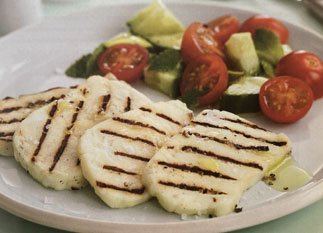Halloumi cheese
Halloumi cheese is a popular semi-hard to hard, elastic, no-rind dairy product of Cypriot origin. Traditionally this stretched curd is made with either sheep's or goat's milk and stored in brine.
Halloumi's fibrous, rubbery texture is particularly suited to cooking. It is one popular dairy products in the Middle East and the Mediterranean regions of Europe, and its popularity has grown manifold in recent years in the U.S and Canada.
 |
Halloumi cheese is categorized as a fresh and non-cultured dairy product. It is packaged in a brine solution to prevent drying out and to preserve.
Halloumi is a protected designation of origin (PDO), according to which the cheese must be made in South Cyprus. But a similar type of cheese made in Turkey is called hellim.
Halloumi cheese manufacturing:
Halloumi is simple to make and only requires a few equipment; a large vat, wooden ladle, curd knife, large colander, cheese mold and cloth, draining mat, and thermometer.
Slowly heat the milk to 33-34 °C.
Add liquid rennet at this temperature, cover the pot, and let the curd mixture sit undisturbed for 40-60 min. This coagulates milk protein (casein protein in the milk) and separates it from the liquid whey.
Cutting the curd for Halloumi: The curd is divided into 1' pieces, allow it to rest further 10 minutes or so. This results in a larger surface area to aid in easing the whey separation by increasing the surface areas.
Stir gently while raising the whey temperature slowly to 100-106° F (38-40° C) for 20 to 30 minutes. Allow the curd to rest at this temperature for 5-10 minutes more to settle.
Then transfer curd to square/circular molds lined with cheesecloth. The cloth was folded to cover the upper surface of the curd. The curd was then pressed for 60 min. A pressure of 300 kPa was applied for the first 15 min then the pressure was increased to 400 kPa for the remaining time.
Once all the whey drained and curd settled, cut into blocks (10 X 15 x 3 cm).
Transfer the blocks and cook the whey for 1 hour at 94-96° C (do not boil) till the cheese floats to the surface, which is the final part of making Halloumi.
Drain and cool, knead, and flatten with a slight hand pressure to form a larger and flatter disc of cheese. sprinkle dry salt (3%), and dry spearmint (Mentha viridis) leaves.
Fold crossways and leave to chill overnight.
Storage in 11% NaCl brine for 3-4 weeks.
Health benefits of Halloumi cheese
Halloumi is a high-calorie, nutritious cheese composed of protein, essential fatty acids, minerals, and vitamins. 3.5 Oz (100 g) of fresh cheese in brine holds 313 calories and 23.5 g of total fats.
Halloumi provides high-quality protein complete in all of the essential amino acids vital for growth and development. 100 g halloumi contains 23.9 g or about 43% of the recommended daily intake of protein.
It is a gluten-free dairy product. It is another important alternative source of gluten-free food items rich in protein, minerals, and vitamins.
Halloumi is a very good source of dietary calcium, magnesium, and phosphorous in the Mediterranean diet. Along with vitamin D, these minerals help in bone strengthening and growth, particularly in children.
Halloumi contains a small amount of lactose (1.5 g/3.5 Oz) making it one of the low-lactose dietary sources of protein & calcium for persons with lactose intolerance.
Halloumi is very good source of fat-soluble vitamins, especially vitamin A. 3.5 Oz (100 g) of fresh halloumi contains 1073 IU (36% of RDI) of this vitamin.
Being a fresh, non-cultured cheese, halloumi composes 201 μg of natural flavonoid pigment compounds β-carotene.
Together with flavonoids, vitamin-A plays an essential role in the integrity of mucosa, skin, and hair. It is also an essential component for good night vision. Consumption of natural foods rich in flavonoids has been found to offer protection against lung, esophagus, and oral cavity cancers.
Fresh halloumi is an excellent source of several essential B-complex groups of vitamins such as folates, riboflavin, pyridoxine, thiamin, and pantothenic acid.
Halloumi is a very concentrated source of minerals, especially calcium (794 mg or 79% of DV), phosphorus (517 mg or 74% of DV), magnesium (40 mg or 10% of DV), zinc (3.7 mg or 34% of DV) and selenium (12 μg or 22% of RDI).
| Principle | Nutrient Value | Percent of RDA |
|---|---|---|
| Energy | 313 Kcal | 15.5% |
| Carbohydrates | 1.7 g | 1.3% |
| Protein | 23.9 g | 43% |
| Total Fat | 23.5 g | 117.5% |
| Dietary Fiber | 0 g | 0% |
| Vitamins | ||
| Folates | 40 μg | 10% |
| Niacin | 0.100 mg | <1% |
| Pyridoxine | 0.100 mg | 7.7% |
| Riboflavin | 0.390 mg | 30% |
| Thiamin | 0.03 mg | 2.5% |
| Vitamin-A | 1073 IU | 36% |
| Vitamin-C | 0 mg | 0% |
| Vitamin-D | 8 IU | 1.3% |
| Vitamin-E | 0.60 mg | 4% |
| Electrolytes | ||
| Sodium | 1200 mg | 80% |
| Potassium | 88 mg | 2% |
| Minerals | ||
| Calcium | 794 mg | 79.4% |
| Copper | Traces | 0% |
| Iron | Traces | 0% |
| Magnesium | 40 mg | 10% |
| Phosphorus | 517 mg | 74% |
| Selenium | 12 μg | 22% |
| Zinc | 3.7 mg | 34% |
Buying
Classical Cypriot halloumi is manufactured from sheep's or goat's milk from the breeds native to the region. The European Union recognizes traditional Cyprus halloumi as a product of Protected Designation of Origin (PDO).
It is nowadays increasingly being manufactured by using cow's milk or a combination of sheep/goat's milk to satisfy consumer demand.
Halloumi/Hellim is a semi-hard, white cheese with an elastic, squeaky texture and neutral flavor. Its body is compact with no holes and has no obvious rind.
It characteristically has a high melting point, allowing it to be grilled, pan-seared, or fried.
Look for the date of manufacture, packing, and use-by while buying.
Halloumi samples that conformed to the Cypriot standards for full-fat (25.75 ± 3.14%), reduced-fat (at least 25% fat reduction from full-fat), and low-fat (at least 50% fat reduction from full-fat).
Storing
Un-opened halloumi can store below 0°C for many months. If you have any left-over halloumi you bought an air-seal pack from a grocery, store it in home-made brine and place it in the refrigerator for use in the next 2-4 weeks.
Once opened, it should be kept in the fridge for use in the next 5-7 days, like feta.
Food uses
Halloumi's main characteristic is that it withstands heat and has a high melting point. Cooking also removes its saltiness to a great extent and produces a crunchy crust on the outside and a soft texture inside with an appealing milky flavor.
It is an ideal cheese for frying or for grilling. It is also consumed directly or in salads.
 |
| Halloumi cheese- grilled. |
The halloumi can also be consumed fresh at room temperature in cheese platters, appetizers, and sandwiches, topped on bread, salads, pizza, or pie, and even grated on fresh pasta.
Traditionally, Cypriots enjoy halloumi served in a watermelon salad during summer months due to its crispy, squeaky texture and salty and fresh lactic flavor.
It is one of the cheeses employed in Saganaki, a pan-fried Greek appetizer.
Safety profile
Halloumi cheese is one of the very high sodium and fat content dairy items in common with other brined cheeses like feta or domiati.
High salt diet may cause water retention and elevated blood pressure.
Halloumi composes about 15g of saturated fats/3.5 Oz, making it one of the high saturated fat food items. Saturated fats raise your LDL (bad) cholesterol which increases the risk for heart disease and stroke.
(Medical Disclaimer: The information and reference guides on this website are intended solely for the general information of the reader. It is not to be used to diagnose health problems or for treatment purposes. It is not a substitute for medical care provided by a licensed and qualified health professional. Please consult your health care provider for any advice on medications.)
≻≻-You may also like to read
≺≺ Feta cheese nutrition facts.
≺≺ Ricotta cheese nutrition facts.
≺≺ Cheddar cheese nutrition facts.
≺≺ Brie cheese nutrition facts.
≺≺-Back to Dairy products from Halloumi cheese nutrition facts.
≺≺-Back to Home page.
Further Resources:
Composition of foods integrated dataset (CoFID). (Excel sheets-Sl No-617, opens in new window).
The characterization of the physicochemical and sensory properties of full-fat, reduced-fat, and low-fat ovine and bovine Halloumi: - American Dairy Science Association (opens in new window).
Halloumi cheese-the product and its characteristics . (Pdf-opens in new window).